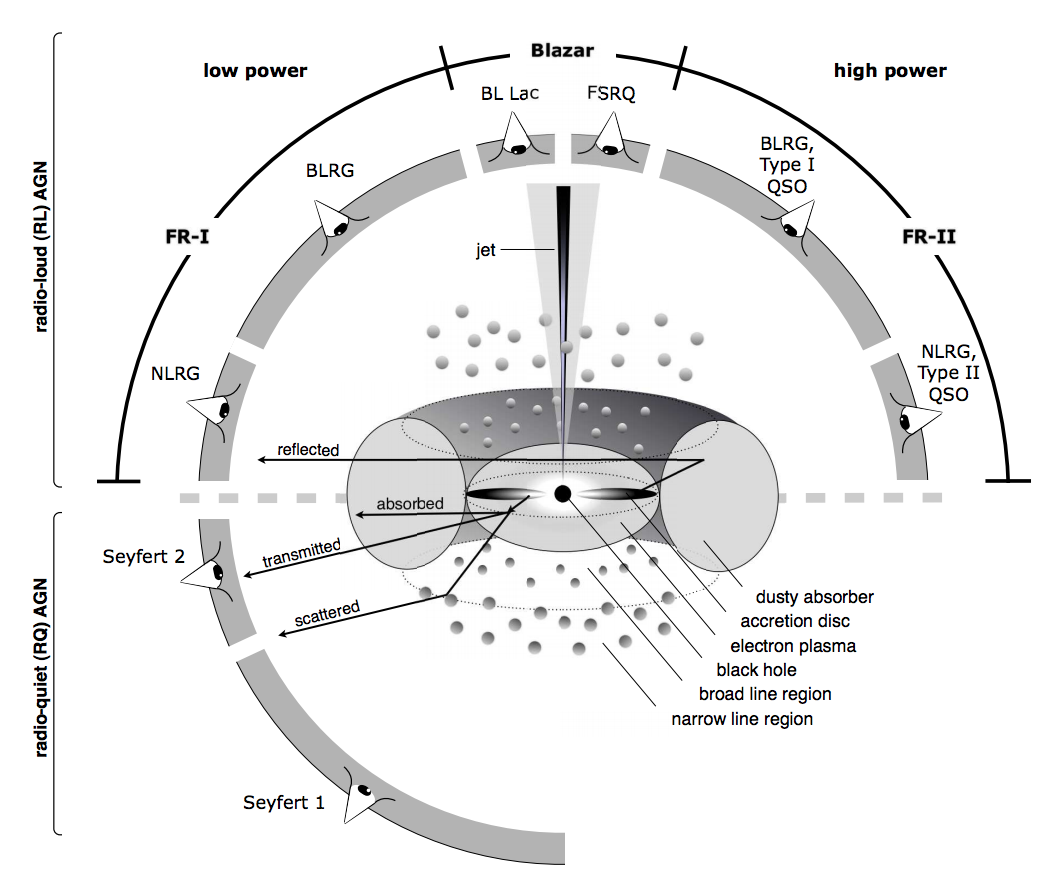
- Schematic representation of our understanding of the AGN phenomenon in the unified scheme. The type of object we see depends on the viewing angle, whether or not the AGN produces a significant jet emission, and how powerful the central engine is. Note that radio loud objects are generally thought to display symmetric jet emission. Graphic courtesy of Marie-Luise Menzel (MPE).
We can found a big classification of AGNs, depending in principle by the presence (or absence) of broad permitted lines, the band of the spectra we are observing, the intensity of the nuclear luminosity and the radio properties of the object. This means that an object can be placed in two or more types of AGN, depending of his physics characteristics.
Low-ionization nuclear emission-line regions (LINERs) As the name suggests, these systems show only weak nuclear emission-line regions, and no other signatures of AGN emission. It is debatable whether all such systems are true AGN (powered by accretion on to a supermassive black hole). If they are, they constitute the lowest-luminosity class of radio-quiet AGN. Some may be radio-quiet analogues of the low-excitation radio galaxies.
Seyfert galaxies Were the earliest distinct class of AGN to be identified. They show optical nuclear continuum emission, narrow and (sometimes) broad emission lines, (sometimes) strong nuclear X-ray emission and sometimes a weak small-scale radio jet. Originally they were divided into two types known as Seyfert 1 and 2: Seyfert 1s show strong broad emission lines while Seyfert 2s do not, and Seyfert 1s are more likely to show strong low-energy X-ray emission. Various forms of elaboration on this scheme exist: for example, Seyfert 1s with relatively narrow broad lines are sometimes referred to as narrow-line Seyfert 1s. The host galaxies of Seyferts are usually spiral or irregular galaxies.
Low Luminosity AGN (LLAGN) Are AGN with luminosities that are much smaller than “normal” AGN, and have luminosities less than 1% of the Eddington luminosity. They lack the “Big Blue Bump” that we see in the UV in many AGNs (which is believed to be generated by the Comptonization of photons by a hot corona above the accretion disk), Therefore, it has been proposed that these objects do not have the inner region of the accretion disk which would produce that UV Bump; it has been theorized that the inner region is a radiatively-inefficient flow.
Radio-quiet quasars/QSOs These are essentially more luminous versions of Seyfert 1s: the distinction is arbitrary and is usually expressed in terms of a limiting optical magnitude. Quasars were originally ‘quasi-stellar’ in optical images, and so had optical luminosities that were greater than that of their host galaxy. They always show strong optical continuum emission, X-ray continuum emission, and broad and narrow optical emission lines. Some astronomers use the term QSO (Quasi-Stellar Object) for this class of AGN, reserving ‘quasar’ for radio-loud objects, while others talk about radio-quiet and radio-loud quasars. The host galaxies of quasars can be spirals, irregulars or ellipticals: there is a correlation between the quasar’s luminosity and the mass of its host galaxy, so that the most luminous quasars inhabit the most massive galaxies (ellipticals).
Radio-loud quasars These behave exactly like radio-quiet quasars with the addition of emission from a jet. Thus they show strong optical continuum emission, broad and narrow emission lines, and strong X-ray emission, together with nuclear and often extended radio emission.
Blazars (BL Lac objects and OVV quasars) These classes are distinguished by rapidly variable, polarized optical, radio and X-ray emission. BL Lac objects show no optical emission lines, broad or narrow, so that their redshifts can only be determined from features in the spectra of their host galaxies. The emission-line features may be intrinsically absent or simply swamped by the additional variable component: in the latter case, emission lines may become visible when the variable component is at a low level.[7] OVV quasars behave more like standard radio-loud quasars with the addition of a rapidly variable component. In both classes of source, the variable emission is believed to originate in a relativistic jet oriented close to the line of sight. Relativistic effects amplify both the luminosity of the jet and the amplitude of variability.
Fanaroff-Riley Type 1 (FR I) Are best known for their distorted (not well collimated) jets that don’t have distinct termination points. They have jets that appear disrupted, rather like distorted plumes, and appear as two-sided, apparently subsonic jets. It also seems that there is a fairly good separation in radio energy emitted by FR I’s and FR2’s. The FR classification came from first defining R_FR as the ratio between the distance from the core of the highest radio surface brightness to the distance of the low-power radio width. If R_FR < 0.5, the source was classified as a FR I radio galaxy. More intuitively, FR I galaxies are those radio galaxies with their regions of low surface brightness farther from the core, or highest surface brightness closer to the core.
Fanaroff-Riley Type 2 (FR II) Simply put, they have jets that appear smooth and un-distorted, and appear as one-sided, apparently supersonic jets. In the original classification scheme of Fanaroff & Riley, FR II galaxies were those with R_FR > 0.5. In the Unification Scheme, FR II galaxies are considered the counterparts of Radio Loud Galaxies. Also, it is generally believed that FR II galaxies have optically thick material obscuring the source.